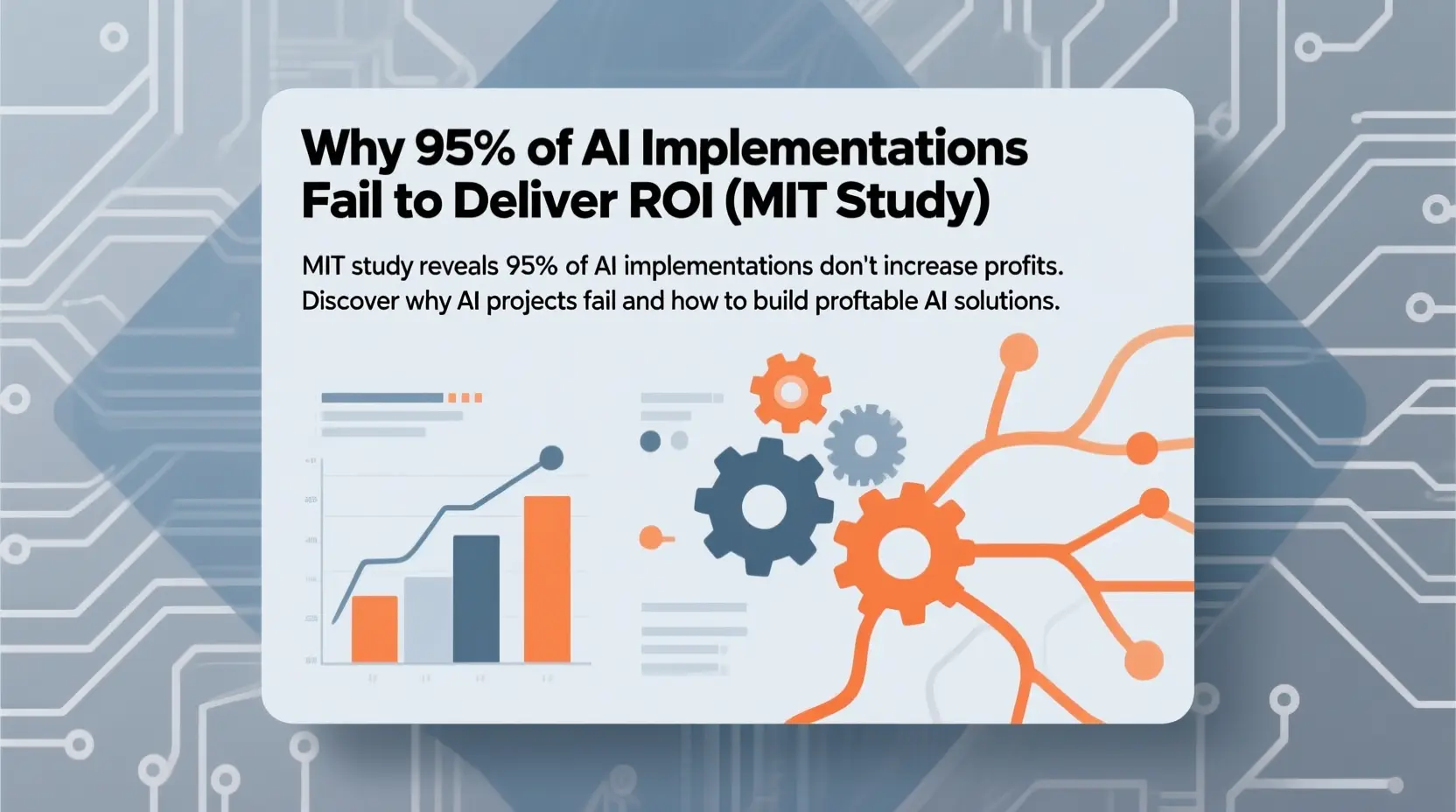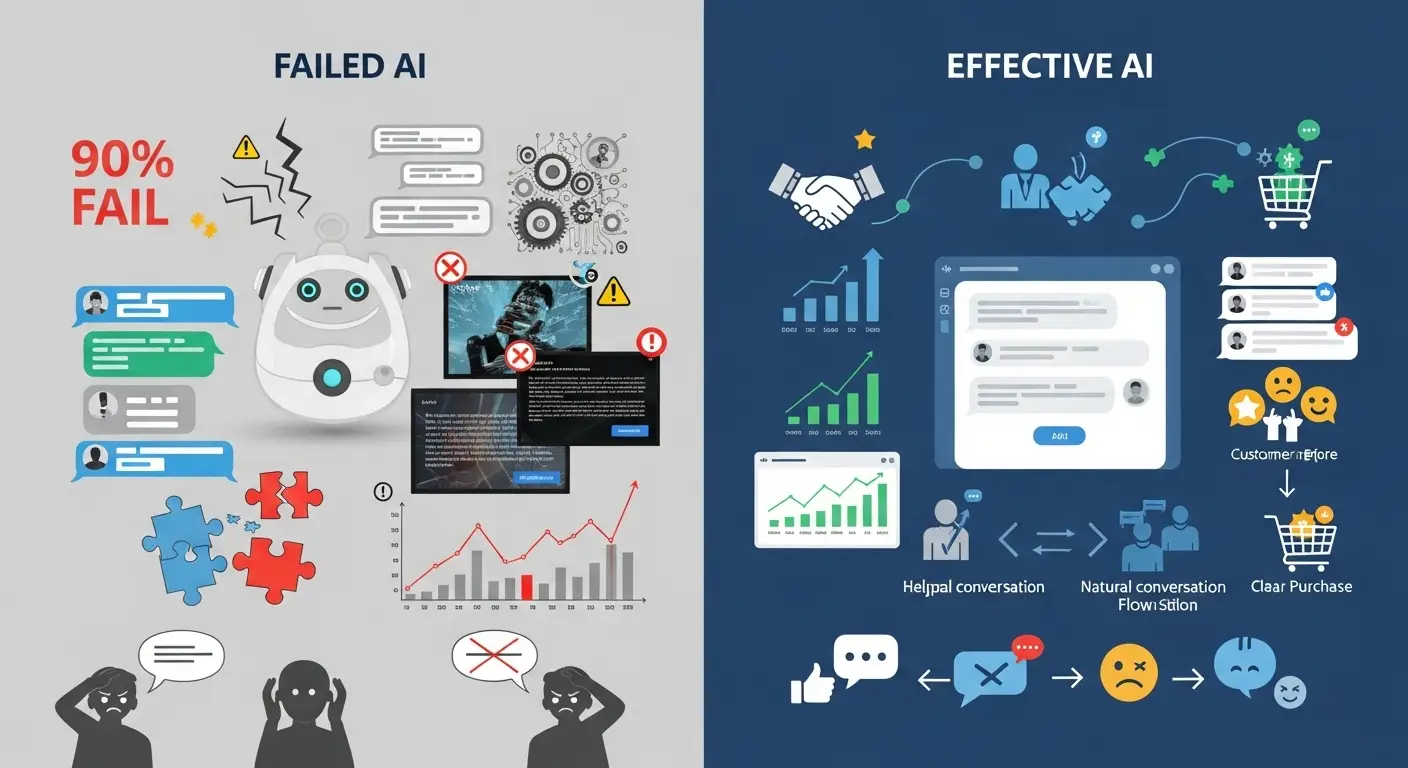The $100 Billion AI Reality Check That’s Shaking Silicon Valley
A bombshell MIT research report has sent shockwaves through the technology sector, revealing that 95% of AI implementations fail to increase company profits. The study, which analyzed thousands of AI deployments across industries, has sparked intense debate on r/technology and beyond, with one Reddit user commenting: “It’s another quick fix solution. Often and more widely AI solutions take more time and effort to implement in a scalable and efficient way than traditional solutions.”
This revelation comes at a time when businesses have poured over $100 billion into AI initiatives over the past three years, expecting transformative returns that simply haven’t materialized. For ecommerce leaders, this study raises critical questions: Are we approaching AI implementation all wrong? And more importantly, how can we avoid becoming part of that 95% failure statistic?
The implications extend far beyond Silicon Valley boardrooms. As one technology professional noted in the Reddit discussion, “The problem still AI isn’t really it’s just agents and logic/decision structures on new weird.” This sentiment captures a fundamental misunderstanding that’s costing companies millions in failed AI projects.
The Anatomy of AI Implementation Failure
The Hype Cycle Trap
The MIT study reveals a pattern that’s become all too familiar in the technology sector: the disconnect between AI promises and AI reality. Companies are investing in AI not because they’ve identified specific problems it can solve, but because they feel pressured to “do something with AI” or risk being left behind.
The numbers paint a stark picture:
- Average AI project budget: $2.3 million
- Success rate for delivering promised ROI: 5%
- Time to realize benefits: 18-36 months (when successful)
- Companies that abandon AI projects within first year: 67%
This failure pattern isn’t unique to AI. We saw similar trends with big data initiatives in the 2010s, where Gartner reported that 85% of big data projects failed to deliver business value. The common thread? Technology-first thinking rather than problem-first implementation.
The Integration Nightmare
One of the most insightful comments from the Reddit discussion highlighted a critical issue: “AI integration with existing systems is incredibly complex.” This complexity manifests in several ways:
Technical Integration Challenges:
- Legacy system compatibility issues
- Data quality and standardization problems
- Scalability limitations of AI models in production
- Security and compliance complications
- Real-time performance requirements vs. AI processing delays
Organizational Integration Challenges:
- Resistance to change from existing workforce
- Lack of AI literacy among decision-makers
- Unclear ownership of AI initiatives
- Insufficient training and change management
- Misaligned expectations between technical teams and business stakeholders
The “AI Washing” Phenomenon
Perhaps most damaging is the practice of “AI washing” – labeling traditional software solutions as “AI-powered” to capitalize on market enthusiasm. As one Reddit user astutely observed, “There are endless ways this bad can be oversold.”
This practice has led to:
- Inflated expectations for basic automation tools
- Confusion about what constitutes genuine AI capabilities
- Skepticism toward legitimate AI solutions
- Wasted resources on ineffective “AI” implementations
- Decreased confidence in AI technology overall
Why Most Ecommerce AI Projects Miss the Mark
Problem #1: Solution in Search of a Problem
The most common failure pattern in ecommerce AI implementation follows this sequence:
- Executive Decision: “We need AI to stay competitive”
- Technology Selection: Choose popular AI tools or platforms
- Implementation: Deploy AI without clear success metrics
- Reality Check: Minimal impact on business metrics
- Abandonment: Project quietly discontinued
Real-world example: A major retailer spent $1.8 million on an AI-powered product recommendation engine that increased conversion rates by just 0.3% – well below the 2-5% improvement needed to justify the investment.
Problem #2: Data Quality Delusions
AI is only as good as the data it’s trained on, yet most ecommerce companies vastly overestimate the quality and usefulness of their existing data. Common data issues include:
- Incomplete customer profiles: 70% of ecommerce customer data is fragmented across multiple systems
- Poor data hygiene: Duplicate records, outdated information, inconsistent formatting
- Behavioral data gaps: Limited understanding of customer intent and context
- Siloed information: Marketing, sales, and customer service data rarely integrate effectively
Problem #3: The “Set It and Forget It” Mentality
Many businesses treat AI implementation like installing traditional software – deploy once and expect consistent results. However, AI systems require continuous:
- Model retraining as customer behavior evolves
- Performance monitoring to detect degradation
- Data pipeline maintenance to ensure quality inputs
- User feedback integration to improve accuracy
- Competitive adaptation as market conditions change
Problem #4: Misaligned Success Metrics
The MIT study revealed that most AI projects fail because they optimize for the wrong metrics. In ecommerce, this often manifests as:
- Focusing on engagement over conversion: High click-through rates that don’t translate to sales
- Optimizing for averages: Improving overall metrics while neglecting high-value customer segments
- Short-term thinking: Prioritizing immediate gains over customer lifetime value
- Technology metrics over business outcomes: Celebrating model accuracy while ignoring revenue impact
The 5% That Actually Deliver: What Makes AI Implementation Successful
Characteristic #1: Problem-First Approach
Successful AI implementations start with a clearly defined business problem, not a technology solution. These companies follow a rigorous framework:
Business Problem Definition:
- Quantify the current cost of the problem
- Define specific, measurable success criteria
- Identify the minimum improvement needed for ROI
- Map the problem to existing business processes
Example: Instead of “implement AI for better customer experience,” successful companies define problems like “reduce cart abandonment rate from 68% to 50% within 6 months to increase revenue by $2.4 million annually.”
Characteristic #2: Hybrid Human-AI Approach
The most successful AI implementations don’t replace humans – they augment human capabilities. This approach recognizes that:
- AI excels at: Pattern recognition, data processing, consistent responses, 24/7 availability
- Humans excel at: Complex problem-solving, emotional intelligence, creative solutions, contextual understanding
Successful framework:
- AI handles routine, data-driven tasks
- Humans manage complex, high-stakes interactions
- Seamless handoff mechanisms between AI and human agents
- Continuous learning from human-AI interactions
Characteristic #3: Iterative Implementation Strategy
Rather than attempting large-scale AI deployments, successful companies adopt an iterative approach:
Phase 1: Proof of Concept (2-3 months)
- Limited scope implementation
- Clear success/failure criteria
- Minimal investment and risk
Phase 2: Pilot Program (3-6 months)
- Expanded scope with specific user groups
- Detailed performance tracking
- User feedback collection and integration
Phase 3: Scaled Deployment (6-12 months)
- Full implementation with learned optimizations
- Change management and training programs
- Continuous improvement processes
Characteristic #4: Cross-Functional Collaboration
Successful AI projects involve deep collaboration between:
- Business stakeholders: Define problems and success criteria
- Technical teams: Implement and maintain AI systems
- End users: Provide feedback and adoption insights
- Data teams: Ensure quality and accessibility of information
- Customer-facing teams: Bridge AI capabilities with human touch
Industry Deep Dive: Ecommerce AI Success Stories
Case Study: Conversational Commerce Revolution
While most ecommerce AI implementations focus on behind-the-scenes optimization, the most successful applications create direct customer value through enhanced interaction experiences.
Traditional Approach (Typical Failure Pattern):
- Deploy chatbot to reduce customer service costs
- Focus on deflecting human interactions
- Optimize for response speed over quality
- Result: Frustrated customers, minimal cost savings
Successful Approach (Conversational Commerce):
- Use AI to enhance customer shopping experience
- Focus on increasing conversion rates and order values
- Optimize for customer satisfaction and sales outcomes
- Result: Higher conversion rates, increased customer lifetime value
Performance Comparison:
- Traditional AI chatbots: 15% customer satisfaction, 0.8% impact on conversion rates
- Conversational commerce AI: 85% customer satisfaction, 25-30% conversion rates
The Technology Stack That Works
Successful ecommerce AI implementations typically involve:
Layer 1: Data Foundation
- Unified customer data platform
- Real-time behavioral tracking
- Quality data pipelines
- Privacy-compliant data practices
Layer 2: AI Processing Engine
- Natural language processing for customer communication
- Predictive analytics for personalization
- Computer vision for product recognition
- Machine learning for continuous optimization
Layer 3: Integration Layer
- CRM system connectivity
- Inventory management integration
- Payment processing compatibility
- Marketing automation synchronization
Layer 4: Human Interface
- Seamless AI-to-human handoff mechanisms
- Agent training and support tools
- Performance monitoring dashboards
- Customer feedback collection systems
The Future of Profitable AI Implementation
Emerging Trends That Matter
1. Context-Aware AI Systems Future AI implementations will better understand situational context, leading to more relevant and valuable interactions. This includes:
- Customer emotional state recognition
- Purchase intent prediction
- Real-time inventory and pricing optimization
- Personalized communication timing
2. Multimodal AI Experiences Integration of text, voice, and visual AI capabilities will create more natural and effective customer interactions:
- Voice-enabled shopping assistance
- Visual product search and comparison
- Augmented reality try-before-buy experiences
- Interactive product demonstrations
3. Predictive Customer Journey Optimization AI will shift from reactive to proactive customer engagement:
- Anticipating customer needs before they’re expressed
- Preventing problems before they occur
- Optimizing the entire customer lifecycle, not just individual interactions
- Creating personalized shopping experiences at scale
The Convergence of AI and Human Expertise
The most promising direction for AI implementation involves creating systems where artificial intelligence and human intelligence complement each other seamlessly. This approach recognizes that:
- AI provides scale, consistency, and data processing power
- Humans provide empathy, creativity, and complex problem-solving
- The combination delivers experiences that neither could achieve alone
Strategic Recommendations for Ecommerce Leaders
Immediate Actions (Next 30 Days)
1. Conduct an AI Readiness Assessment
- Audit existing data quality and accessibility
- Identify specific business problems worth solving
- Calculate potential ROI for targeted improvements
- Assess team capabilities and training needs
2. Define Success Metrics Before Technology Selection
- Establish baseline performance measurements
- Set specific, time-bound improvement targets
- Identify leading and lagging indicators of success
- Create accountability structures for project outcomes
3. Start Small with High-Impact Opportunities
- Choose one well-defined use case for initial implementation
- Focus on areas with clear customer and business value
- Ensure quick wins are possible within 90 days
- Plan for iterative expansion based on learnings
Medium-term Strategy (3-6 Months)
1. Build Cross-Functional AI Teams
- Include business, technical, and customer-facing perspectives
- Establish clear roles and responsibilities
- Create regular communication and feedback mechanisms
- Develop shared vocabulary and understanding of AI capabilities
2. Invest in Data Infrastructure
- Implement unified customer data platforms
- Establish data quality monitoring and improvement processes
- Create real-time data pipelines for AI consumption
- Ensure compliance with privacy regulations
3. Pilot Conversational Commerce Solutions
- Test AI-powered customer interaction systems
- Measure impact on conversion rates and customer satisfaction
- Optimize handoff processes between AI and human agents
- Scale successful implementations gradually
Long-term Vision (6+ Months)
1. Develop Proprietary AI Capabilities
- Build internal expertise rather than relying solely on vendors
- Create competitive advantages through unique AI applications
- Establish continuous learning and improvement processes
- Foster innovation culture around AI experimentation
2. Create Integrated Customer Experience Ecosystems
- Connect AI capabilities across all customer touchpoints
- Develop consistent personalization across channels
- Build predictive customer journey optimization
- Measure and optimize lifetime customer value
3. Establish AI Excellence Centers
- Share learnings and best practices across the organization
- Develop internal AI implementation methodologies
- Create training and development programs
- Build partnerships with AI research institutions
The Bottom Line: Avoiding the 95% Failure Rate
The MIT study’s findings shouldn’t discourage AI investment – they should inform smarter implementation strategies. The 5% of successful AI projects share common characteristics that any ecommerce business can adopt:
Success Factor #1: Clear Problem Definition Start with business problems, not technology solutions. Quantify the current cost and define specific success criteria before evaluating AI options.
Success Factor #2: Human-AI Collaboration
Design AI systems that augment human capabilities rather than replacing them. Create seamless handoff mechanisms and optimize for combined human-AI performance.
Success Factor #3: Iterative Implementation Avoid big-bang deployments. Start with proof of concepts, expand through pilots, and scale based on demonstrated value.
Success Factor #4: Continuous Optimization Treat AI implementation as an ongoing process, not a one-time project. Continuously monitor performance, collect feedback, and adapt to changing conditions.
Success Factor #5: Customer Value Focus Prioritize implementations that directly improve customer experiences and business outcomes over those that simply reduce costs or automate existing processes.
The companies that avoid the 95% failure rate understand that successful AI implementation requires more than just technology – it requires a fundamental shift in how businesses approach customer engagement and value creation.
For ecommerce leaders ready to join the 5% of successful AI implementations, the path forward is clear: start with customer problems, design human-AI collaboration, implement iteratively, and optimize continuously. The technology exists to create transformative customer experiences and business results – the question is whether you’ll approach it with the discipline and focus required for success.
Book Your Live Demo to see how conversational commerce AI can deliver the ROI that 95% of implementations miss.



